Introduction
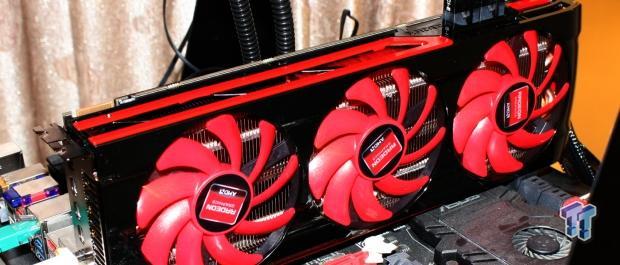
AMD's Radeon HD 7990 name has been thrown around for a while now. Rumor had it that the video card we're looking at today was going to show up sometime last year. Of course that didn't happen, and we saw some partners take matters into their own hands by releasing dual GPU cards that sported two HD 7970 GPUs. Primarily the two we're talking about are the HIS Radeon HD 7970 3GB IceQ X2 and PowerColor DEVIL13 Radeon HD 7990 6GB, with the latter card also being looked at overclocked.
With a $999 price tag, AMD are joining the $1,000 club that NVIDIA have been sitting in for a while with the GeForce GTX TITAN; a truly beast of a single GPU card. Out of the box the EVGA GTX TITAN 6GB SuperClocked impressed us immensely. If that wasn't enough performance for you overclocking brought with it even more performance, thanks to a strong core clock speed increase. If $1,000 wasn't enough then throwing a second card into the mix and discovering the awesomeness that a $2,000 video card setup brings in the form of SLI is truly amazing. We'll have that article online soon.
Today though we get the chance to finally see what AMD does with a $1,000 video card. Of course being a reference card means that we don't have any form of package, instead we'll just get straight into the card to see what's going on with the new model. Once we've done that we'll move onto the specification side of things and find the main details.
We'll then take a quick moment to look at our testbed before we cover the cards that you'll see in our graphs today before finally checking out the performance of the new dual GPU model.
The Card and Specifications
The Card

Unlike the GTX TITAN which also carries a $1,000 price tag, the HD 7990 6GB really looks like a mean expensive video card with a massive three fan setup that covers it completely left to right. The cooler is an absolute beast and the press documents from AMD have put a large focus on the quietness of the cooler. Looking above it would come as no surprise this is a quiet cooler due to the multi fan setup which allows for the fans to spin at a lower speed while pushing more air than a single higher RPM fan.
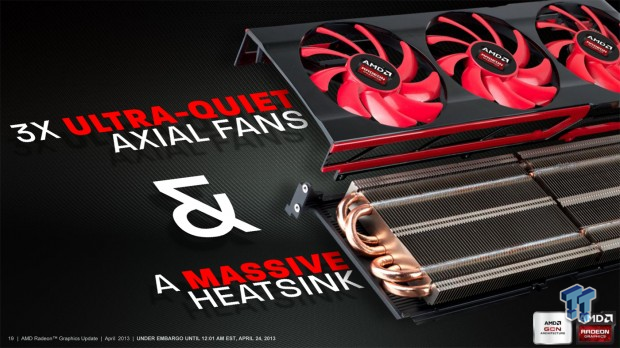
Outside of the three fan setup, I think what's really awesome is the massive heatsink that sits behind it. You can see that it is split into two parts - one hovering over each GPU, and four copper heat pipes protrude at the end. This is a really massive card that looks and feels fantastic. We'll see later in the review if the cooler performs as well as it looks.
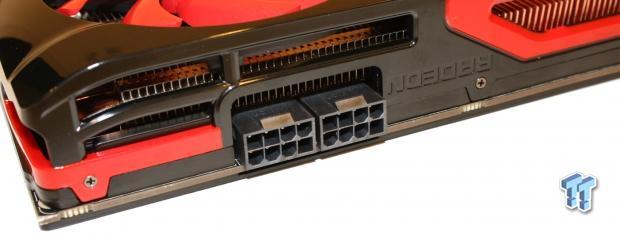
Taking a look around you can see power comes in the form of two 8-pin PCIe power connectors. This doesn't come as much of a surprise, if anything we're probably slightly more surprised by the fact we've got only two power connectors since the PowerColor Devil13 carried with it three 8-pin PCIe power connectors. You can see the position is slightly more forward than you'd expect, as well.

Staying across the top, but moving to the front, you can see a single CrossFire connector, which means we can run this card with just one other HD 7990. That's not a surprise as we know CrossFire technology goes up to four GPUs as a maximum. You can also see a little switch that we've seen present on higher end AMD offerings, and it switches between two BIOSs. We'll no doubt learn more about how companies intend to make use of it when we see retail versions of the card in the market. If past experiences are anything to go by, we'll more than likely see companies offer two different speeds - one stock and one overclocked, with the flick of the switch.

The I/O side of things is the area I really love. As someone who is a massive fan of DisplayPort, it's awesome to see AMD opt for four mini DisplayPort connectors, alongside one Dual-Link DVI - it allows a total of five monitors. I really wish NVIDIA would embrace DP technology more and offer something like this.
Specifications
Specification wise the HD 7990 shares a lot of similarities to the HD 7970 GHz with the main difference being that most of the numbers are simply just doubled due to the fact we're dealing with two cores. We're still dealing with a 28nm core, although in this case two. Transistors are doubled to 8.6 billion, Stream processors also to 4,096, Texture units to 256, ROPs to 64 and memory interface to 2x 384-bit.
Compared to the stock HD 7970 GHz Edition clocks are nearly identical. The core has been slightly reduced 50MHz to an even 1,000MHz, and the 6GB of GDDR5 carries the same 6,000MHz QDR clock.
Essentially we're dealing with a pair of HD 7970 GHz Edition video cards on a single PCB, with just a 50MHz decrease on the core.
Benchmarks - Test System Setup
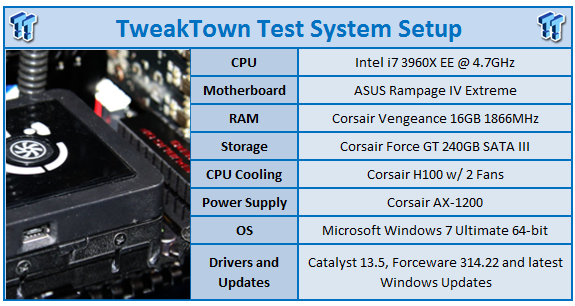
We would like to thank the following companies for supplying and supporting us with our test system hardware and equipment: Intel, ASUS and Corsair.
The lineup of cards in our graphs today focus heavily on high-end setups. From the AMD side we've got the HD 7990 6GB, along with the HD 7970 GHz Edition and the PowerColor HD 7950 overclocked to over 1100MHz on the core.
The NVIDIA side consists of the GTX 650 Ti Boost in SLI via reference cards and Gainward ones that are overclocked to over 1100MHz. We've also got the EVGA GTX TITAN 6GB SuperClocked running at its out of the box speeds, at 975MHz on the core and again at its out of the box speeds, but in SLI.
While only a single GPU solution, it's fair to say that the GTX TITAN is the main competition for AMD's new model, due to both being around the $1,000 mark.
The FPS Numbers Explained
When we benchmark our video cards and look at the graphs, we aim to get to a certain level of FPS which we consider playable. While many may argue that the human eye can't see over 24 FPS or 30 FPS, any true gamer will tell you that as we climb higher in Frames Per Seconds (FPS), the overall gameplay feels smoother. There are three numbers we're looking out for when it comes to our benchmarks.
30 FPS - It's the minimum number we aim for when it comes to games. If you're not dropping below 30 FPS during games, you're going to have a nice and smooth gaming experience. The ideal situation is that even in a heavy fire fight, the minimum stays above 30 FPS making sure that you can continue to aim easily or turn the corner with no dramas.
60 FPS - It's the average we look for when we don't have a minimum coming at us. If we're getting an average of 60 FPS, we should have a minimum of 30 FPS or better and as mentioned above, it means we've got some smooth game play happening.
120 FPS - The new number that we've been hunting down over recent months. If you're the owner of a 120 Hz monitor, to get the most out of it you want to get around the 120 FPS mark. Moving from 60 FPS / 60 Hz to 120 FPS / 120 Hz brings with it a certain fluidity that can't really be explained, but instead has to be experienced. Of course, if you're buying a 120 Hz monitor to take advantage of 3D, an average of 120 FPS in our benchmark means that in 3D you will have an average of 60 FPS, which again means you should expect some smooth gameplay.
Why are some graphs incomplete?
Adding new game benchmarks is a long, tedious and time consuming task as every video card has to be re-tested in those new benchmarks. Because of that reason we have always just evaluated our benchmark line up every six months. To stay up to date and current with the latest benchmarks and games available, we've changed our approach to adding new benchmarks.
Our benchmark line up will progress and be updated as newer more intensive games with benchmarks comes to light. While this will mean that initially you may only see a single video card in those particular graphs, as the weeks go on and we test more and more video cards, the results will grow quickly. This will help keep our benchmark line up as up to date as possible as we introduce and remove games on a constant basis.
Benchmarks - 3DMark 11
3DMark 11
Version and / or Patch Used: 1.1
Developer Homepage: http://www.futuremark.com
Product Homepage: http://www.3dmark.com/3dmark11/
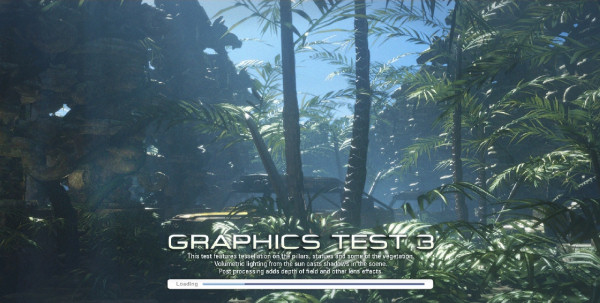
3DMark 11 is the latest version of the world's most popular benchmark. Designed to measure your PC's gaming performance 3DMark 11 makes extensive use of all the new features in DirectX 11 including tessellation, compute shaders and multi-threading. Trusted by gamers worldwide to give accurate and unbiased results, 3DMark 11 is the best way to consistently and reliably test DirectX 11 under game-like loads.
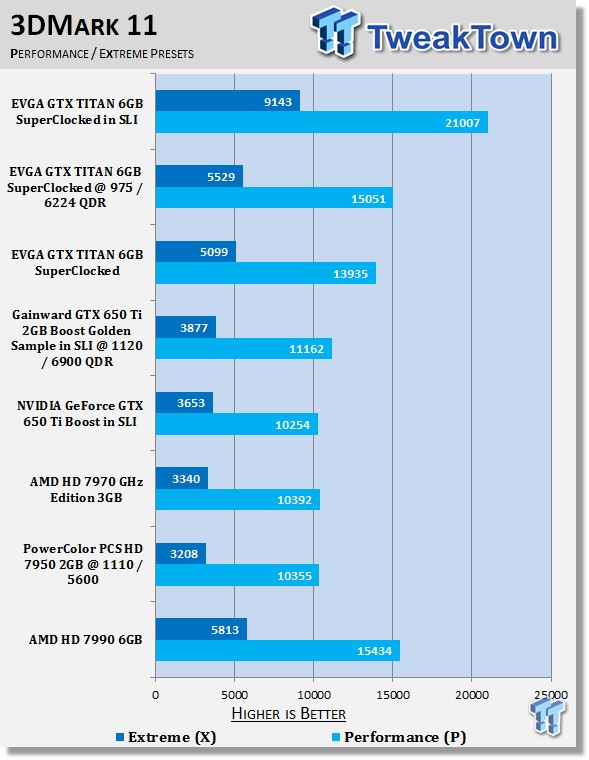
Out of the gate you can see performance sits a little ahead of the EVGA GTX TITAN SuperClocked when it's been overclocked to 975MHz.
We'll have to see if this stays true as we continue our testing. It's going to be especially important when we get to our games.
Benchmarks - Unigine Heaven Benchmark
Unigine Heaven Benchmark
Version and / or Patch Used: 3
Developer Homepage: http://www.unigine.com
Product Homepage: http://unigine.com/press-releases/091022-heaven_benchmark//
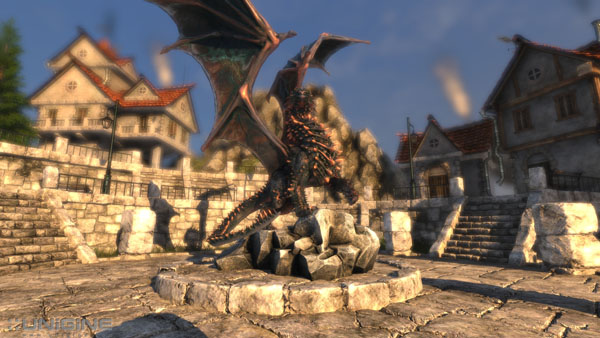
New benchmark grants the power to unleash the DirectX 11 potential in the gift wrapping of impressively towering graphics capabilities. It reveals the enchanting magic of floating islands with a tiny village hidden in the cloudy skies. With the interactive mode emerging experience of exploring the intricate world is ensured within reach. Through its advanced renderer, Unigine is one of the first to set precedence in showcasing the art assets with tessellation, bringing compelling visual finesse, utilizing the technology to the full extend and exhibiting the possibilities of enriching 3D gaming.
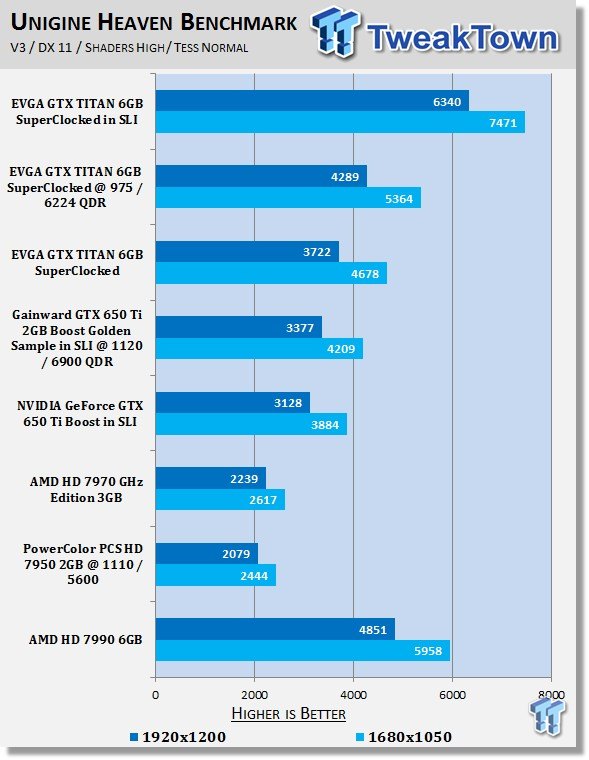
Heaven, a benchmark that tends to favor NVIDIA video cards, is making for a very impressive showing here for the HD 7990 6GB. You can again see we're ahead of the GTX TITAN when overclocked and really it's by a decent chunk - over 10% at the higher resolution.
Benchmarks - Phantasy Star Online 2
Phantasy Star Online 2
Version and / or Patch Used: Standalone Benchmark
Timedemo or Level Used: Built in Benchmark
Developer Homepage: http://www.sega.com/?t=EnglishUSA
Product Homepage: http://www.pso2.com/us/html/index.html
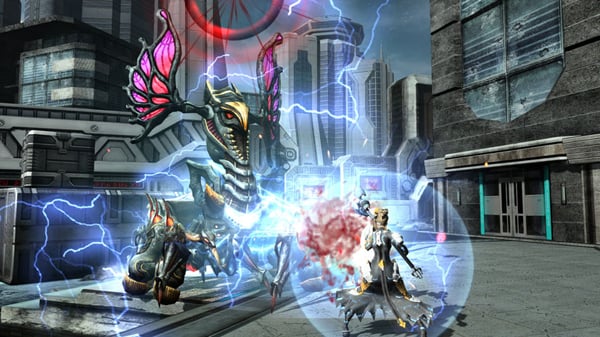
Play Phantasy Star Online 2 and experience revolutionary combat in an action-driven, free-to-play multiplayer online RPG from SEGA. Take a journey into an immersive sci-fi fantasy narrative and explore mysterious worlds to unravel their secrets. Join fellow adventurers and fight against the legions of darkness to banish them from the galaxy.
Score explanation: Less than 2000: Please adjust your game settings because the processing load is quite heavy.
2000 through 5000: The game runs fine at the setting, if you have room, you can adjust some settings.
5001+: The game works wonderfully at this setting.
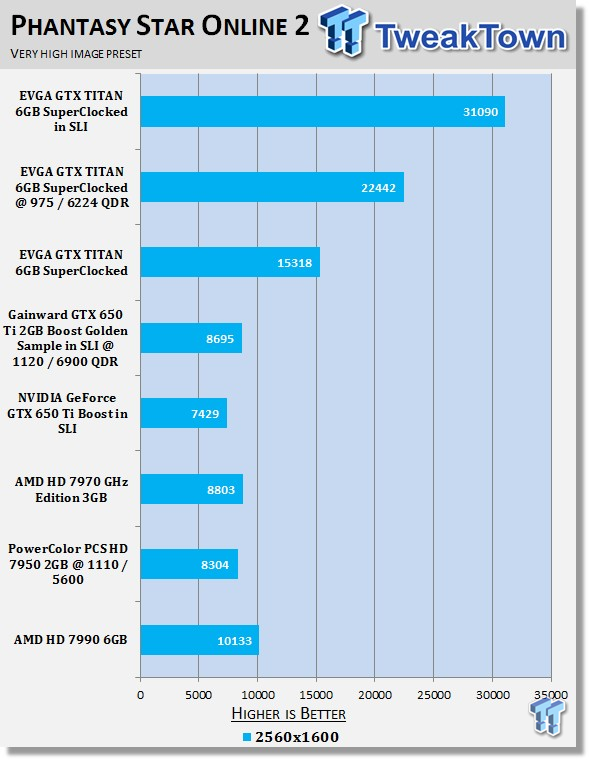
PSO2 performance is very strong being in the 10,000 region. Compared to the GTX TITAN, though, you can see the NVIDIA offering is 50% faster at the SuperClocked speeds and 100% faster when overclocked by us. The main thing is we've got a strong overall score; and at 10,000 points, we do.
Benchmarks - Lost Planet 2
Lost Planet 2
Version and / or Patch Used: Standalone Benchmark
Timedemo or Level Used: Built in Benchmark - Test A Scene 1
Developer Homepage: http://www.capcom.com/
Product Homepage: http://www.lostplanet2game.com/
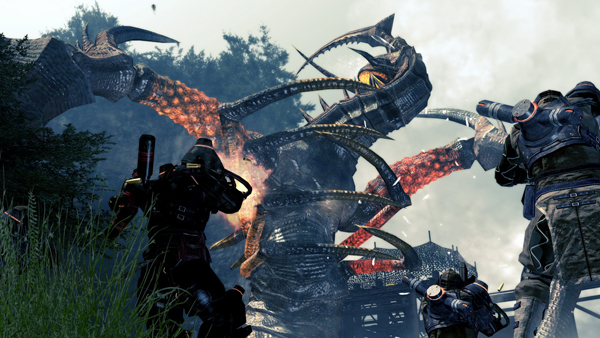
Lost Planet 2 is a third-person shooter video game developed and published by Capcom. The game is the sequel to Lost Planet: Extreme Condition which is also made by Capcom, taking place ten years after the events of the first game, on the same fictional planet. The story takes place back on E.D.N. III 10 years after the events of the first game. The snow has melted to reveal jungles and more tropical areas that have taken the place of more frozen regions. The plot begins with Mercenaries fighting against Jungle Pirates. After destroying a mine, the Mercenaries continue on to evacuate the area, in which a Category-G Akrid appears and attacks them. After being rescued, they find out their evacuation point (Where the Category-G appeared) was a set-up and no pick up team awaited them. The last words imply possible DLC additions to the game, "There's nothing to be gained by wiping out snow pirates... unless you had some kind of grudge."

Lost Planet 2 is another game that tends to favor NVIDIA offerings due to the heavy focus on Tessellation. You can see again, though, performance on the HD 7990 is very strong. Against the GTX TITAN overclocked to 975MHz on the core, you can see it is ahead at all resolutions, with a difference of roughly 10% being seen at the highest resolution.
Benchmarks - Just Cause 2
Just Cause 2
Version and / or Patch Used: Latest Steam Update
Timedemo or Level Used: Dark Tower
Developer Homepage: http://www.eidos.com/
Product Homepage: http://www.justcause.com/
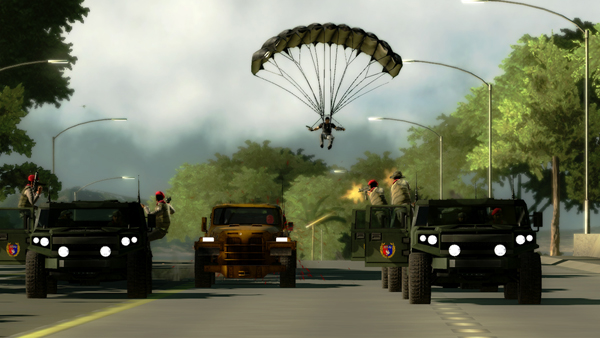
Just Cause 2 employs the Avalanche Engine 2.0, an updated version of the engine used in Just Cause. The game is set on the other side of the world from the original Just Cause, on the fictional island of Panau in Southeast Asia. Panau has varied terrain, from desert to alpine to rainforest. Rico Rodriguez returns as the protagonist, aiming to overthrow the evil dictator Pandak "Baby" Panay and confront his former mentor, Tom Sheldon.

Just Cause 2 performance is extremely strong and again have no problem outperforming the GTX TITAN at 975MHz. At the highest resolution the HD 7990 is over 20% faster.
Benchmarks - F1 2012
F1 2012
Version and / or Patch Used: Latest Steam Update
Timedemo or Level Used: Built in Benchmark
Developer Homepage: http://www.codemasters.com/uk/
Product Homepage: http://www.codemasters.com
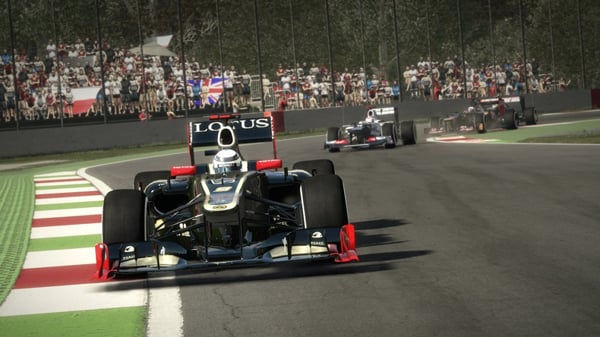
In F1 2012 players will feel the unparalleled thrill of becoming a FORMULA ONE driver with a host of new features, wide-ranging technical and gameplay advancements and extensive competitive and co-operative multiplayer components. F1 2012 will feature all of the official teams, drivers and circuits from the 2012 FIA FORMULA ONE WORLD CHAMPIONSHIP, including the debut of the 2012 FORMULA 1 UNITED STATES GRAND PRIX at Austin, Texas and the return of Germany's famous Hockenheim circuit to the calendar.

F1 2012 seems to hit a wall a bit earlier and because of that you see we're behind the GTX TITAN across the board. The good news is that performance is still very strong and the 100+ FPS average means we're looking at pretty good numbers for people who are on 120Hz monitors.
Benchmarks - Metro 2033
Metro 2033
Version and / or Patch Used: Latest Steam Update
Timedemo or Level Used: Built in Benchmark
Developer Homepage: http://www.4a-games.com/
Product Homepage: http://www.thqnordic.com/
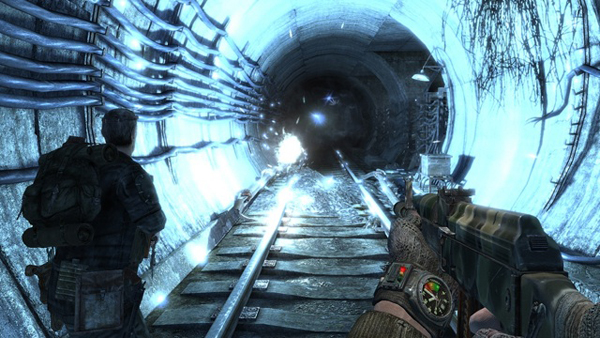
Metro 2033 is an action-oriented video game with a combination of survival horror and first-person shooter elements. The game is based on the novel Metro 2033 by Russian author Dmitry Glukhovsky. It was developed by 4A Games in Ukraine and released in March 2010 for Microsoft Windows and Xbox 360.[3] In March 2006, 4A Games announced a partnership with Glukhovsky to collaborate on the game.[4] The game was announced at the 2009 Games Convention in Leipzig;[5] a first trailer came along with the announcement.[6] A sequel was announced, currently titled Metro: Last Light.

Metro 2033 performance at 1680 x 1050 and 1920 x 1200 sits around the same level as the GTX TITAN SuperClocked at its out of the box speeds. When we move to 2560 x 1600, though, you can see that the HD 7990 separates itself again from the GTX TITAN, with some strong numbers that again equate to over 20%.
Benchmarks - Dirt Showdown
Dirt Showdown
Version and / or Patch Used: Latest Steam Update
Timedemo or Level Used: Built in Benchmark
Developer Homepage: http://www.codemasters.com/uk/
Product Homepage: http://www.codemasters.com/uk/dirtshowdown/360/
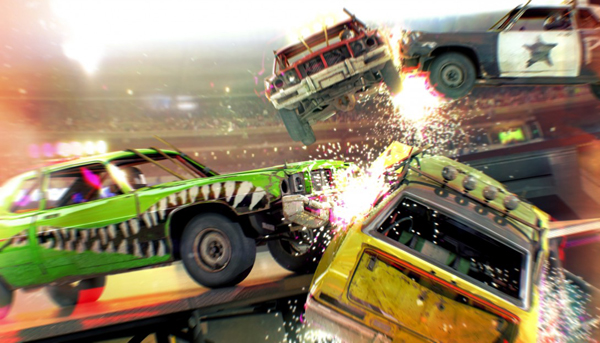
DiRT Showdown is the new arcade racing game from the team that brought you the award-winning DiRT series, uncaged in 2012. Pick up and play controls combine with electrifying events, frenzied crowds and stunning graphics to deliver high octane, dive in and drive thrills from event one.
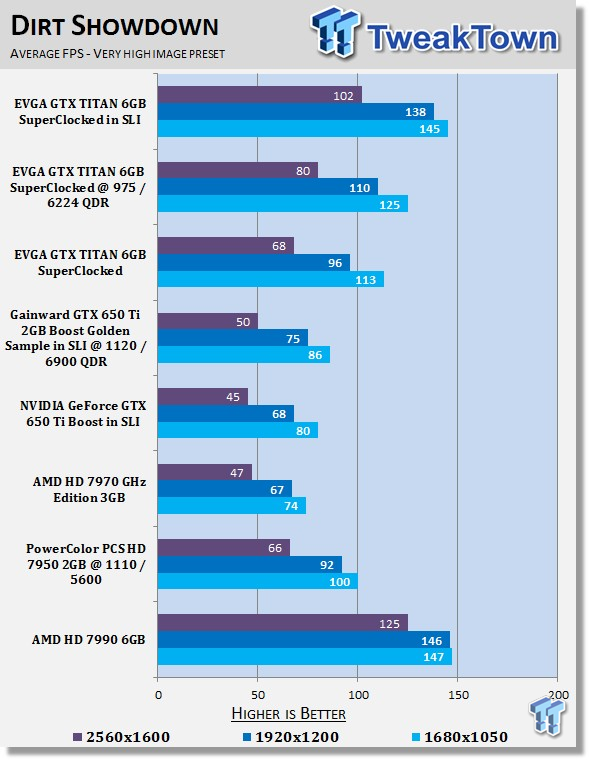
Dirt Showdown has always been a good game for AMD and you can see that the performance on the HD 7990 in this instance is actually ahead of the GTX TITAN in SLI at all resolutions.
Benchmarks - Nexuiz
Nexuiz
Version and / or Patch Used: Latest Steam Update
Timedemo or Level Used: Built in Benchmark
Developer Homepage: http://www.alientrap.org/
Product Homepage: http://www.nexuiz.com/
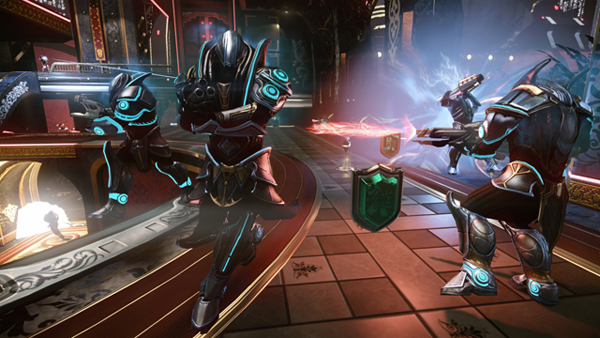
Nexuiz is an Arena First Person shooter coming soon to consoles. Nexuiz is fast paced with extremely competitive game play. IllFonic brings Alientrap Software's Nexuiz to next-gen gaming consoles around the world while staying true to the game play refined over the years through development. IllFonic introduces a new Victorian influenced art style that is simultaneously futuristic and sophisticated. Nexuiz for consoles is powered by CryENGINE 3.
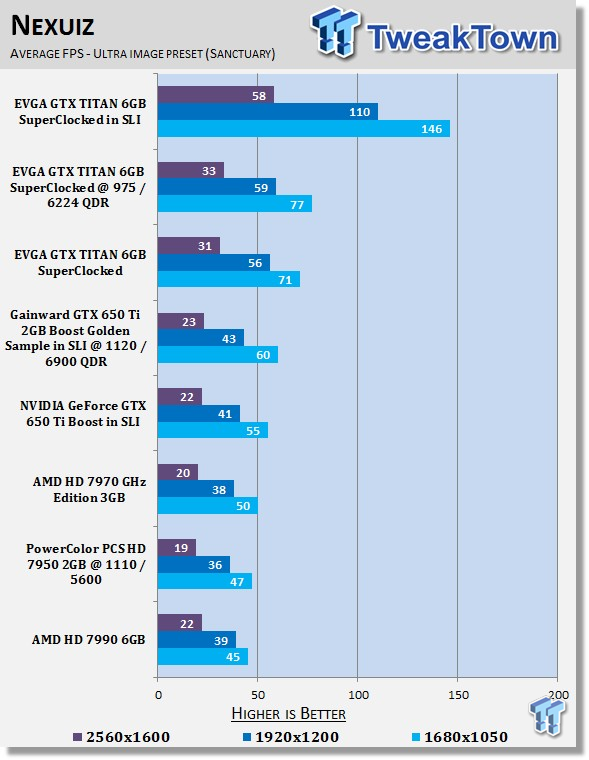
The lack of CrossFire support for Nexuiz means that performance is equivalent to pretty much just a single HD 7970 GHz Edition. Across the board the numbers are unplayable.
This is really disappointing and an issue we continue to see with CrossFire setups under this game. We really hope it's something that AMD addresses as out of all the games, Nexuiz is one that could really utilize the extra GPU power.
Benchmarks - Sniper Elite V2
Sniper Elite V2
Version and / or Patch Used: Standalone Benchmark
Timedemo or Level Used: Built in Benchmark
Developer Homepage: http://www.rebellion.co.uk/
Product Homepage: http://sniperelitev2.com/us/age.html
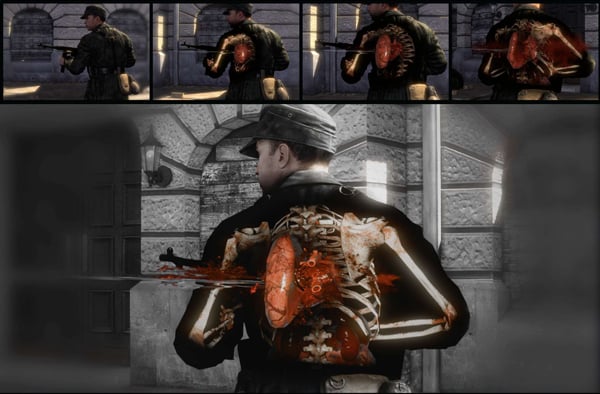
Sniper Elite V2 features detailed sniping simulation with advanced ballistics, taking into account gravity, wind, velocity, bullet penetration, aim stability and more. Guaranteed to provide players with the most realistic simulation of military sharpshooting yet available.

Sniper Elite V2 numbers are strong across the board and you can again see that the GTX TITAN at 975MHz isn't an issue for the new AMD model.
We're also dealing with great numbers for anyone on a 120Hz screen.
Benchmarks - Sleeping Dogs
Sleeping Dogs
Version and / or Patch Used: Latest Steam Update
Timedemo or Level Used: Built in Benchmark
Developer Homepage: http://eu.square-enix.com/en
Product Homepage: http://www.sleepingdogs.net/
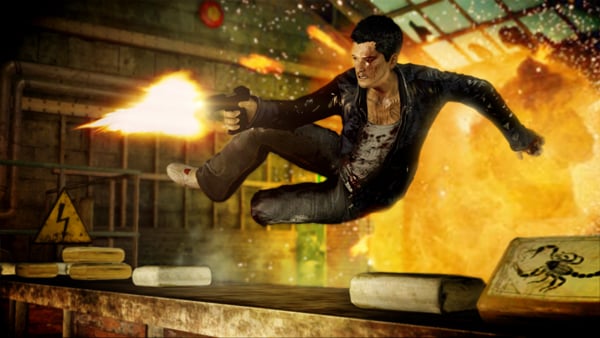
The core gameplay of Sleeping Dogs consists of giving the player an open world environment in which to move around freely. Sleeping Dogs is played as an over-the-shoulder, third-person perspective action-adventure game with role-playing elements. The player controls Wei Shen, a Chinese-American police officer, as he goes undercover to infiltrate the Sun On Yee Triad organization. On foot, the player character has the ability to walk, run, jump, climb over obstacles and swim, as well as use weapons and martial arts in combat. Players also drive a variety of vehicles including cars, boats, and motorcycles.

Sleeping Dog numbers are around the same level as the GTX TITAN when overclocked to 975MHz. You can see, though, that at the highest resolution, the HD 7990 6GB sneaks ahead.
Benchmarks - Far Cry 2
Far Cry 2
Version and / or Patch Used: 1.01
Timedemo or Level Used: Ranch Long
Developer Homepage: http://www.ubi.com/
Product Homepage: http://www.farcry2.com/
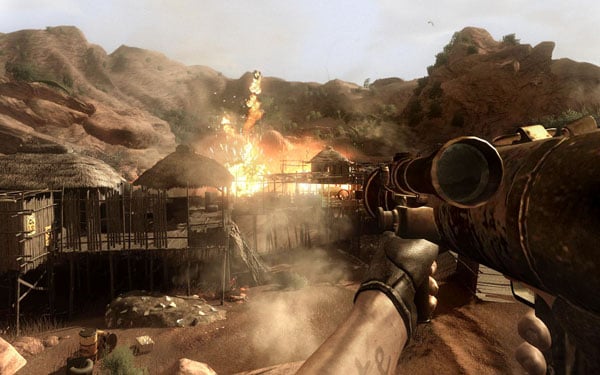
The Dunia Engine was built specifically for Far Cry 2 by the award-winning Ubisoft Montreal development team. It delivers the most realistic destructible environments, amazing special effects such as dynamic fire propagation and storm effects, real-time night-and-day cycle, dynamic music system, non-scripted enemy A.I. and so much more.

Of course for a video card like this we knew that Far Cry 2 was never going to be an issue.
Benchmarks - Hitman Absolution
Hitman Absolution
Version and / or Patch Used: Latest Steam Update
Timedemo or Level Used: Built in Benchmark
Developer Homepage: http://www.ioi.dk/
Product Homepage: http://hitman.com/
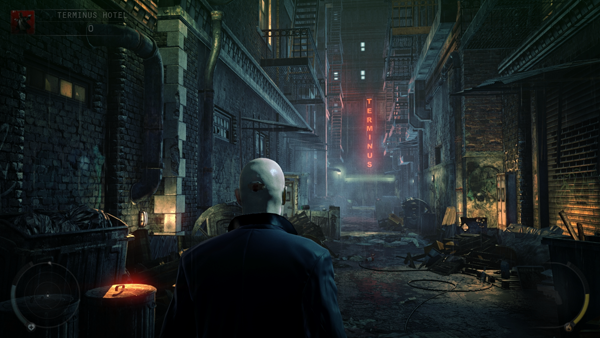
Hitman: Absolution is an action-adventure stealth game developed by IO Interactive and published by Square Enix. It is the fifth entry in the Hitman game series, and runs on IO Interactive's proprietary Glacier 2 game engine. Before release, the developers stated that Absolution would be easier to play and more accessible, while still retaining hardcore aspects of the franchise. The game was released on 20 November 2012, which is in the 47th week of the year (in reference to the protagonist, Agent 47).
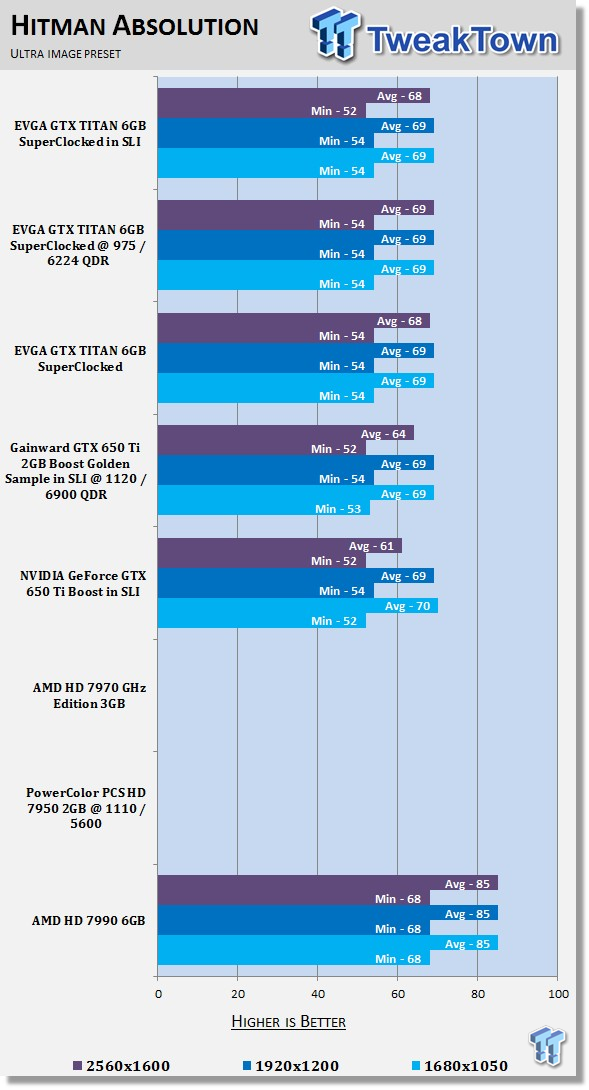
Like the NVIDIA cards, you can see that AMD cards also face this FPS wall. The good news is that the wall comes a little later. As you can see at all resolutions we're getting a 68 FPS minimum and 85 FPS average.
Of course anyone on a 120Hz monitor would prefer that this wall didn't exist, as they could achieve closer to a 120 FPS average.
Benchmarks - Tomb Raider
Tomb Raider
Version and / or Patch Used: Latest Steam Update
Timedemo or Level Used: Built in Benchmark
Developer Homepage: http://www.nixxes.com/
Product Homepage: http://www.tombraider.com/us/base/agegate?refer=184&
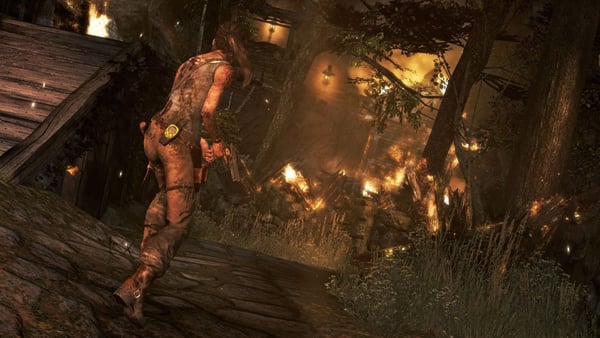
Tomb Raider is an action-adventure platform video game. Published by Square Enix, Tomb Raider is the fifth title developed by Crystal Dynamics in the Tomb Raider franchise. As the first entry in a new Tomb Raider continuity, the game is a reboot that emphasizes the reconstructed origins of the culturally influential lead character Lara Croft. Tomb Raider was released on 5 March 2013 for PlayStation 3, Xbox 360 and Microsoft Windows to universal critical acclaim.

Tomb Raider numbers across the board are pretty good and ahead of the GTX TITAN SuperClocked at all resolutions. The only time we see the GTX TITAN come out ahead is at the highest resolution when it's been overclocked.
Benchmarks - BioShock Infinite
BioShock Infinite
Version and / or Patch Used: Latest Steam Update
Timedemo or Level Used: Built in Benchmark
Developer Homepage: http://irrationalgames.com/
Product Homepage: http://www.bioshockinfinite.com
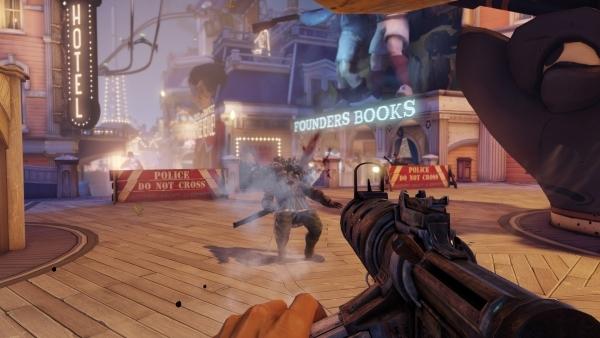
BioShock Infinite is a first-person shooter video game and the third installment in the BioShock series. Previously known as "Project Icarus", it is being developed by Irrational Games and was released worldwide on the Microsoft Windows, PlayStation 3, and Xbox 360 platforms on March 26, 2013. BioShock Infinite is not part of the storyline of previous BioShock games but features similar gameplay concepts and themes.
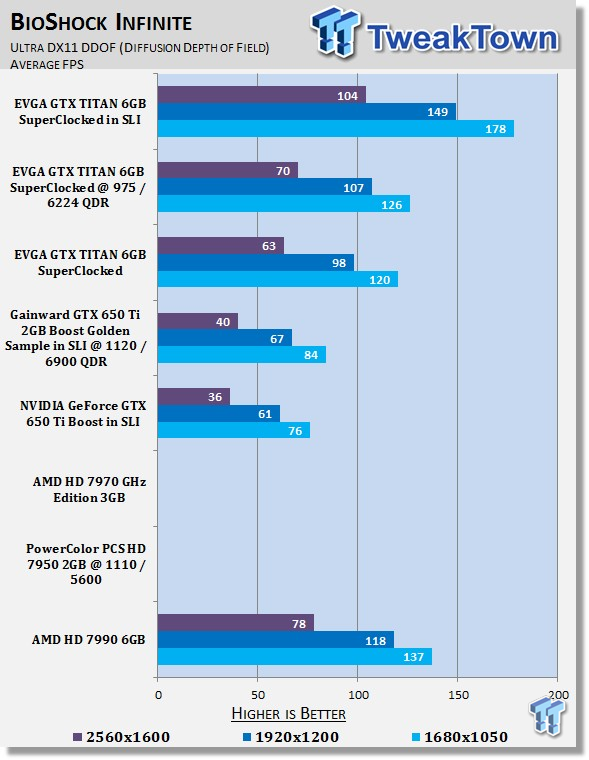
BioShock Infinite performance is strong. AMD's new model is ahead of the overclocked GTX TITAN at all resolutions, and more importantly, we've got playable FPS at all resolutions, including 2560 x 1600.
Benchmarks - High Quality AA and AF
High Quality AA and AF
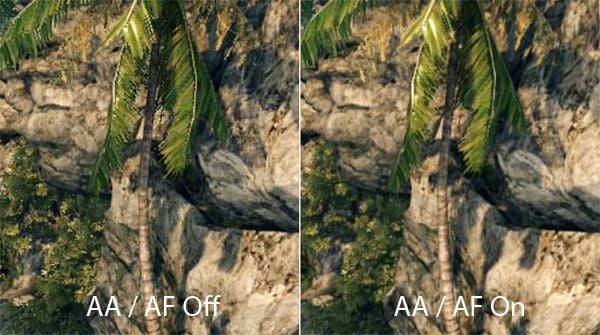
While we test all our games with maximum in-game settings, turning on Anti-Aliasing (AA) and Antistrophic Filtering (AF) helps take the intensity of our testing to another level.
Here we see video cards go from playable FPS to an unplayable FPS and the real power houses continue to help break that 60 FPS mark we always aim for to provide a smooth gaming experience.
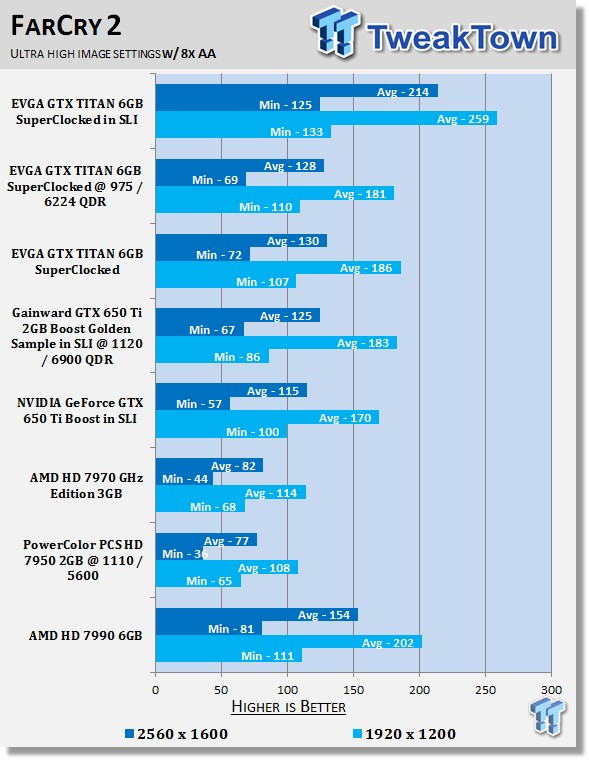
With AA and AF turned on we of course didn't expect Far Cry 2 to be a problem.

Metro 2033 numbers are really good and you can see we're ahead of the GTX TITAN at 975MHz by a good margin - especially at the higher 2560 x 1600 resolution, which is the important one, as the GTX TITAN just scraped into the 60 FPS area.

Just Cause 2 continues the trend of very strong performance that sees the HD 7990 6GB come out ahead of the GTX TITAN when overclocked to 975MHz at both resolutions.

Sleeping Dogs at 1920 x 1200 looks good as we manage almost 80 FPS. Moving to 2560 x 1600, though, you can see we're a good way behind the 60 FPS number we're looking for to provide a solid gaming experience.
Temperature Test

The temperature of the core is pulled from MSI Afterburner with the max reading used after a completed run off 3DMark Vantage and the Performance preset.

Considering the two GPUs and the amount of 3D performance we're dealing with here, the temperature numbers don't look too bad.
You can see we're pretty much in line with the single GPU HD 7970 GHz Edition with just 1c separating them at idle.
Sound Test

Pulling out the TES 1350A Sound Level Meter we find ourselves quickly yelling into the top of it to see how loud we can be.
After five minutes of that we get a bit more serious and place the device two CM away from the fan on the card to find the maximum noise level of the card when idle (2D mode) and in load (3D mode).

Noise levels see the Radeon HD 7990 sit towards the middle of the pack. We're just over a dB louder than the EVGA GTX TITAN SuperClocked.
Overall it's a pretty strong number considering the amount of performance that's on offer from this huge video card. AMD's claims in its press kit about the cooling fans was pretty accurate.
Power Consumption Test

Using our PROVA Power Analyzer WM-01 or "Power Thingy" as it has become quickly known as to our readers, we are now able to find out what kind of power is being used by our test system and the associated graphics cards installed. Keep in mind; it tests the complete system (minus LCD monitor, which is plugged directly into AC wall socket).
There are a few important notes to remember though; while our maximum power is taken in 3DMark06 at the same exact point, we have seen in particular tests the power being drawn as much as 10% more. We test at the exact same stage every time; therefore tests should be very consistent and accurate.
The other thing to remember is that our test system is bare minimum - only a SSD hard drive is used with a single CD ROM and minimal cooling fans.
So while the system might draw 400 watts in our test system, placing it into your own PC with a number of other items, the draw is going to be higher.

Power draw, as you'd expect, is on the high side. You can see that it's almost in line with the dual GPU DEVIL13 from PowerColor, with the main difference being a good amount of wattage being taken off the idle number.
Like we said in our GTX TITAN coverage, if you're looking at buying a video card like this, you should already have, or be buying a quality, high wattage power supply to accommodate it.
Pricing, Availability and Final Thoughts
I suppose the simple question to answer is if you're going to spend $1,000 on a new video card, do you buy a GTX TITAN or the new HD 7990? Unfortunately it really feels like the answer to that question isn't so black and white. I think hands down you could say with confidence that the HD 7990 is clearly the faster video card - it's consistently faster, and at times it's up to 20% faster. When you're talking about dollar for dollar performance, that's a serious difference for the same money.
But... and this really is a big but, I understand the appeal in having just a single GPU solution in your system. The GTX TITAN is damn fast and really anything you throw at it, it handles extremely well, especially when you throw overclocking into the mix. CrossFire is also not perfect and that is extremely obvious under Nexuiz, which uses one of the most recent game engines. Considering it's probably the one game that would benefit so much from the technology, it's always disappointing to see dual GPU AMD solutions perform like single GPU solutions. This isn't an issue for NVIDIA, as the GTX 650 Ti Boost SLI setups have shown strong gains, and the GTX TITAN SLI performance is just insane under the extremely intensive game.
While we can't generally comment on the "bundle" in a review that consists of just a reference card, the bottom line is that the game bundle that is going to be seen on the HD 7990 is just truly insane - a massive amount of games are being offered in the form of Far Cry 3, Blood Dragon, Crysis 3, BioShock Infinite, Tomb Raider, Far Cry 3, Hitman Absolution, Sleeping Dogs and Dues Ex Human Revolution. This just adds an immense amount of value to the product. The bundles that AMD are offering lately are just truly awesome and the BioShock Infinite inclusion with the HD 7790 is something that really stood out for us, as it truly impacts the value of the product, in an extremely positive way.
The cooler is fantastic, but we always expected that it would be. AMD made a big deal in its press kits about it and it really didn't disappoint. We're not surprised, though, as we know from the past that multi fan setups tend to perform extremely well, as they're able to push a lot of air at low noise levels.
Outside of the performance and the cooler, the one area that really stands out is the I/O. The inclusion of four mini DisplayPort connectors is appealing to anyone who is on the multi monitor bandwagon and wants to make use of the technology. The lack of multi DisplayPort options from both AMD and NVIDIA recently is the main reason that I still personally use a HD 6970, which offers four mini DisplayPorts. It's a technology that I'd love NVIDIA to embrace more and AMD to offer more on other models.
Overall this is a very fast video card that performs exceptionally well. It's hard to say that a $999 video card is good value because... well, it's a $999 video card. But the performance of the model against NVIDIA's $1,000 option and the massive games bundle that AMD is bundling means that you're really going to see a lot of bang for your back.
At the end of the day it's pretty simple. If you have $1,000 to spend and you want the fastest single video card solution on the market, the AMD Radeon HD 7990 6GB is hands down the winner. If you're not interested in the dual GPU side of things, then the GTX TITAN is going to continue to be the video card for those who have this level of money to spend.
Finally before we finish off; availability is the last thing that needs to be mentioned. Stock is due to hit etailers in the next two weeks. With partners still not quite having stock, it's fairly safe to assume that for at least the next few weeks or possible months, you're going to just see reference design cards with a different sticker on it. What's going to be the most interesting, though, is true availability - and that we won't know for a couple of weeks. Are companies going to get just a handful of this model or will we really see some good stock levels? If the past is anything to go by, it's probably fairly safe to assume that stock is going to be on the light side.
With no solution coming out any time soon that is going to beat this new AMD model in a single card form, it's fairly safe to purchase the HD 7990 knowing that it's still going to have a fairly long life.

